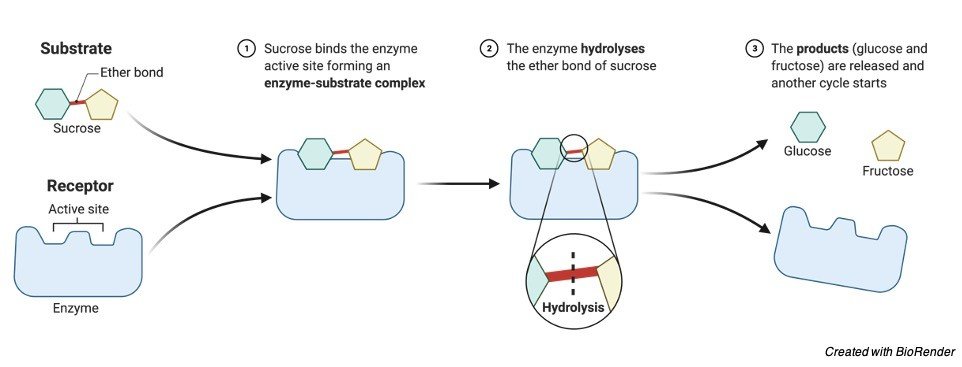Table of Contents
Substrate Definition
The term “substrate” is frequently used in the material sciences to define the basis of a material on which different processing is carried out under specific reaction conditions to produce additional layers and films, such as coatings. As a result, depending on the substrate’s uses and field of research, there are a variety of definitions accessible in the literature. Let us, however, concentrate on the biological side of the substrate.
What is Substrate?
Substrate refers to the underlying substances or layers. The term “substrate” is defined differently in different disciplines of study. It is the main chemical that interacts with the reagent under a set of reaction conditions in key science areas such as chemistry.
To put it another way, the substrate definition in chemistry refers to the chemical reactant that is involved in the chemical reaction and on which an enzyme will operate. The substrate is described as the fundamental surface to which the paint adheres in other connected science disciplines, such as basic engineering.
The compounds that enzymes react with are referred to as substrates in biochemistry. The substrate is the basis on which an immobile material is bonded in ecology. The substrate, in basic terms, is the surface or substance from which an organism develops or receives sustenance. The term “substrate” is sometimes known as “substratum” or “underlayer.”
(1) In ecology, the earthy material where an organism dwells or the surface or medium where an organism develops or is connected is referred to as the substrate. It is the material at the bottom of marine environments (e.g. soil, boulders, sand, gravel) in marine ecosystems. It can be used as a location to live, a stream bed (or an aquarium), or a food source for microorganisms. (2) In biochemistry, a substrate is any chemical that an enzyme reacts with. Substratum and underlayer are synonyms.
Substrate Examples
Below are some examples of substrates in biology areas, including biochemistry, plant ecology, reptile ecosystems, and microbial ecology.
i. In Biochemistry
The substrate is defined in biochemistry as any chemical that interacts with an enzyme’s active site. Between the active site and the substrate, a chemical connection is established. Hydrogen bonds, hydrophobic contacts, and weak Van der Waals forces are used to bind the substrate to the active sites in such processes, which are also known as enzyme-catalyzed reactions. After the enzyme-substrate complex is formed, the enzyme exerts a force on the substances, which causes them to be transformed into products.
In such a complex, an enzyme requires a well-defined substrate to carry out its catalytic activities, whereas numerous active spots in the enzymes’ bodies draw substrates to them. Substrate specificity refers to the process through which enzymes activate particular substrates. As a result, the substrates are loaded onto those active sites, allowing for the formation of comparatively weaker connections between them.
ii. Enzyme-Substrate Complex
Enzyme (E) + Substrate (S) → Enzyme-Substrate or ES Complex
The interaction between the active sites and the substrate takes place under certain conditions, resulting in an enzyme-substrate complex, which causes the substrate to become part of the reaction product.
Although the substrate becomes part of the product, the enzyme undergoes multiple conformational modifications, changes in size and shape, and changes in physicochemical characteristics. Refer to the enzyme and substrate schematic diagram below.

The majority of molecules found in the human body are substrates in their early stages. There are numerous reactions that occur in daily life, and the majority of them require a large amount of energy or extended response periods to meet the completion conditions. As a result, enzymes aid the reaction by decreasing the activation energy and increasing their reaction rates, allowing biological and chemical reactions to proceed smoothly.
The physiochemical characteristics of the substrate change once the reaction is complete, depending on the reaction conditions and the type of the product produced. It’s worth noting that many reactions need many steps to complete, which are referred to as intermediate reactions.
Until the last step in such processes, the product of one reaction becomes the reactant of another. As a result, it may be inferred that substrates, in conjunction with enzymes, play a critical part in many of the processes that occur in our environment.
Enzyme and Substrate Concentration
Many researchers have explained that the availability of the appropriate amount of substrate is essential for an enzyme’s successful functioning, as a rise in the amount of substrate increases the rate of concentration of enzyme activity. Even if there are plenty of substrates available, the rate of reaction will grow after some time until it reaches a certain value, but the rate of enzyme activity will not change. The buildup of substrates in the enzyme’s active sites is the cause of this. As a result, once you reach that level, the enzyme activity will remain constant.
Substrates play a key role in the manufacturing of a variety of sweetening agents, as well as the modification of antibiotics and the production of various washing agents. They also have a variety of uses in the therapeutic, forensic, and environmental fields.
ii. In Plant Ecology
The substrates on which diverse plants, bacteria, and reptiles grow are the most palpable components of our ecosystem, and hence, the substrate’s influence on ecology is immense. Because it is the mechanism through which plants and other creatures receive water and nutrients from the soil, the substrate is critical to their development and nutrition.
It’s worth noting that substrates differ from natural soil in terms of the percentage of organic matter present, as natural soil has a concentration of organic matter of 1-3 percent, whereas substrates have a concentration of organic matter of at least 70%.
The substrates are divided into two kinds on a global scale. There are two types of substrates: universal and specialised. They’re frequently found in peat, perlite, and organic fertiliser mixtures.
The substrates can also be distinguished from one another based on the plants to which they are intended to be applied. Acidic plants, green plants, blooming plants, cactus, succulents, gardens, orchids, carnivorous plants, rose bushes, and seed buds all thrive on them.
iii. In Reptile Ecosystem
The reptile enclosure is primarily made up of surfaces for reptiles. According to many sources, the relationship between the reptile and the substrate must be carefully examined because not all substrates are suitable for all reptiles. The substrate composed of synthetic biodegradable materials, for example, is not ideal for lizards since they sniff with their tongue and the substrate may adhere to it, causing significant gastrointestinal disease.
As a result, regularly monitoring the animal and its natural environment is a smart place to start when choosing a substrate for the reptile. Some of the most frequent substrates for reptiles are silica desert sands, calcium sands, wood fibre substrates, beech chips, bark substrates, and coco fibre.
iv. In Microbial Ecology
Microbes generate enzymes in order to get nutrition and energy by breaking down complicated organic substrates. As a result, it’s been assumed that the extracellular enzymes’ activity is heavily influenced by the substrate composition. The researchers discovered that there are a few key processes that may be used to investigate how differences in substrate composition impact enzymic activity.
The resource limitation concept and the substrate simulation model are the mechanisms. Scientists think that the variety and amount of substrates accessible to microorganisms have a significant impact on their microbial activity, and that both of these processes are at play.
For example, increasing the variety of the substrate increases enzyme activity since the substrate is available to numerous enzymes, as the substrate simulation model has successfully demonstrated. The substrate stimulation concept is possible because the substrate’s variety increases the number of niches available to microorganisms, opening the way for the creation of a more diverse community of bacteria.
Similarly, the resource constraint model accurately anticipated the kind and quantity of enzyme activity, as well as its dependency on the composition of the substrates supplied.
Synergistic effects can emerge from the addition of complementary resources, such as the addition of carbon and nitrogen molecules combined, can have far more beneficial impacts on enzymic acidity than feeding both carbon and nitrogen alone, as evidenced by the resource restriction model. As a result, it is clear that the substrate composition and concentration have a significant impact on the enzymes’ catalytic activity. Furthermore, maintaining the balance between their activities necessitates the use of an appropriate enzyme and a substrate.
Biological Importance of Substrate
A substrate is the earthy substance or surface on which different microorganisms, such as plants, fungi, and algae, live, grow, and adhere. For example, the algae on the rock may serve as a substrate for another living creature that lives on top of the algal underlayer, while the rock itself could be considered a substrate for the algae.
The substrate in an aquatic environment is the material that forms the bed of a stream or the bottom of the ocean. As a result, it encompasses rocks, sand, gravel, and soil. As a result, they are critical as a source of minerals and nutrients, particularly for species that live and grow in the area. Bottom dwellers are additionally protected from predators because they may camouflage and are difficult to spot near the bottom.
Although there are several instances of substrates in various disciplines, there are many typical substrates that we encounter in our daily lives. Enzymes like maltase and salivary amylase use carbohydrates as substrates, such as glucose, starch, and sucrose. Proteins and peptides are the substrates of the enzymes trypsin and chymotrypsin, which are found in a variety of foods such as cereals and meats that humans ingest on a regular basis. The Lipase enzyme’s substrates are lipids.
Substarte in Summary
As a result of the preceding explanation, it can be inferred that the underlying substances or layers are referred to as substrates, albeit the terminology differs depending on the field. Substratum is a term that has frequently been used as a synonym for substrate. A substrate is the molecule that an enzyme interacts with. Furthermore, each enzyme requires a well-defined substrate to carry out its catalytic activities, despite the fact that the enzymes’ bodies include several active regions that draw substrates to them. Substrate specificity refers to the process through which enzymes activate particular substrates.
through which enzymes activate particular substrates. The majority of molecules found in our bodies start off as substrates. The interaction between the active sites and the substrate takes place under certain conditions, resulting in an enzyme-substrate complex, which causes the substrate to become part of the reaction product. Many researchers have explained that the availability of the appropriate amount of substrate is essential for an enzyme’s successful functioning, as a rise in the amount of substrate increases the rate of concentration of enzyme activity.
Substrates have a wide range of uses that differ from one field to the next. Substances that operate on the active sites of enzymes are referred to as substrates in biochemistry. As a result, new bonds between the active sites and the substrates are generated. Enzyme-catalyzed reactions are another name for these types of reactions.
Substrates are the surfaces on which different microorganisms, such as plants, fungi, and algae, dwell in ecology. As a result, any other organism that lives on top of algae will use the algae on the rock as a substrate, while the algae itself will use the rock as a substrate.
Microbes generate enzymes in order to get nutrition and energy by breaking down highly complicated organic substrates. The compositions of the substrates have a big impact on the extracellular enzymes’ activity.
Substrate Citations
- Substrate-Enzyme Interactions in Intramembrane Proteolysis: γ-Secretase as the Prototype. Front Mol Neurosci . 2020 May 19;13:65.
- Alternative Substrate Metabolism in Yarrowia lipolytica. Front Microbiol . 2018 May 25;9:1077.
- The substrate repertoire of γ-secretase/presenilin. Semin Cell Dev Biol . 2020 Sep;105:27-42.
Share












